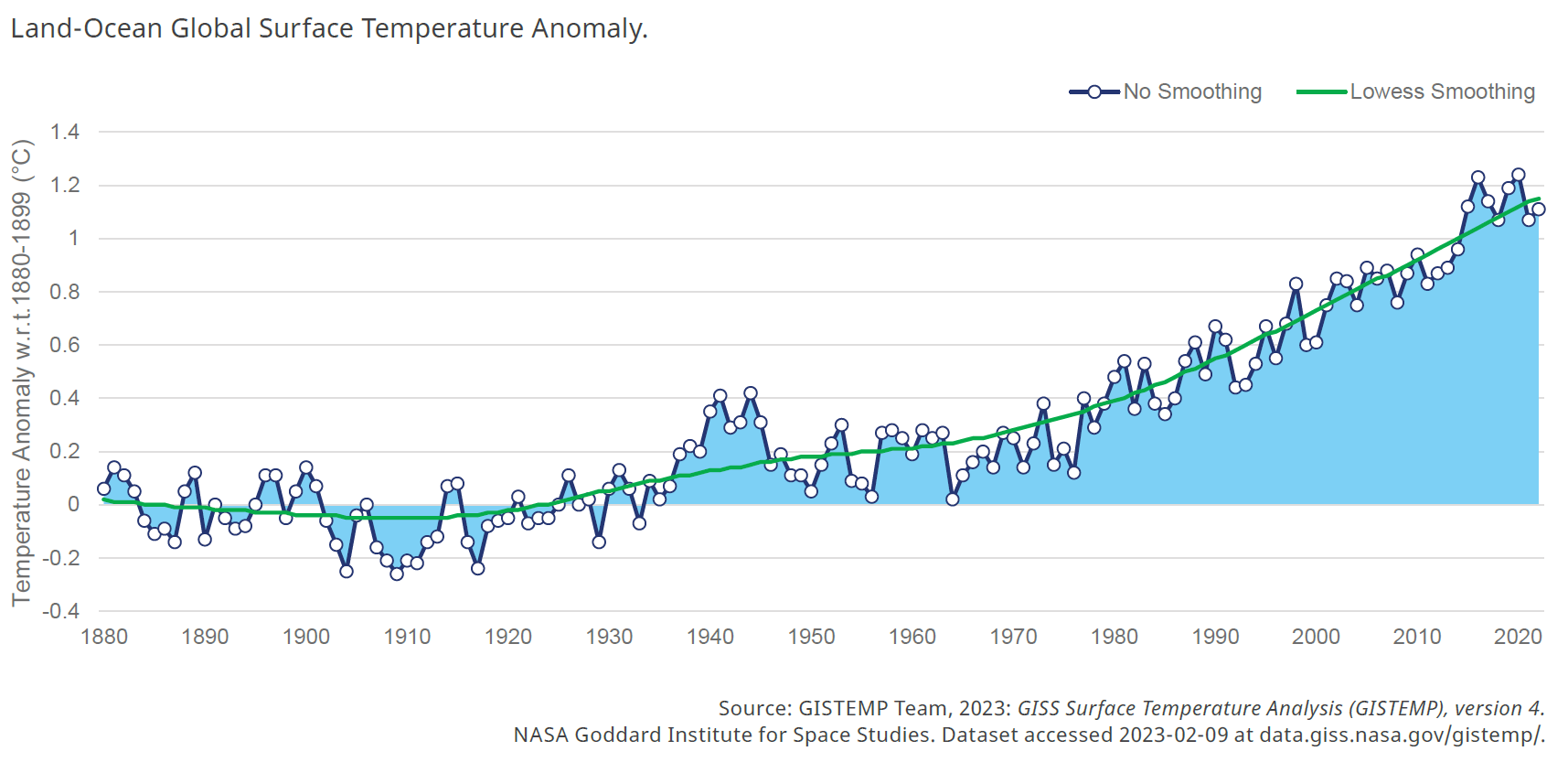
Climate change and extreme weather are increasingly important for multiple stakeholders, including regulators, rating agencies, investors and risk managers. This briefing examines how climate change affects physical risks posed to insurers with exposure in the Middle East and Africa, and the evolution of regulation associated with this risk.
Introduction
There is increasing pressure on insurers to understand climate change’s impacts on damaging weather. The National Aeronautics and Space Administration (NASA) reported that 2022 was the fifth-warmest year on record, with the average surface temperature 1.11°C warmer than pre-industrial times (see figure below).
The increase in global temperature is likely to reach 1.5°C between 2023 and 2027, according to the World Meteorological Organization. These seemingly small increases in temperature can have a large non-linear impact on a wide range of perils, including drought, flood and tropical cyclone. Without a radical reduction in emissions, 3°C of warming is likely before the end of the century, which would bring more severe consequences.
Recent events, such as the floods in eastern South Africa (April 2022) and record-breaking monsoonal rainfall in Pakistan (summer 2022), have been partially attributed to climate change, and the extreme heat in Morocco and Algeria (April 2023) was assessed as almost impossible without climate change. (Re)insurers can avoid unexpected losses—and help achieve long-term growth and profitability—by quantifying their exposure to the physical risk of climate change. (See figure below. Click the image to see larger version of the graph.)
Managing Climate Change Physical Risk In The Middle East And Africa
Regulation
Climate change presents 2 key forms of financial risk: those associated with a transition to a lower-carbon economy, and those related to the physical impacts of climate change. While these risks can and do exist by themselves, they can also be exacerbated by climate-related litigation.
The physical risk impacts can be assessed and reported as either chronic or acute. Chronic physical risks are gradual changes in weather patterns, such as rising sea levels, droughts and extreme temperatures. Acute physical risks are sudden and severe events that can cause significant damage to property and infrastructure, such as hurricanes, floods, wildfires and storms. Mandatory reporting of these risks, often aligned with the recommendations of the Task Force on Climate-Related Financial Disclosures (TCFD), has come into effect in several jurisdictions. Scenario analysis has also emerged as a key forward-looking tool to assess and disclose the potential impact of climate risks.
With the region having just hosted the 2022 United Nations Climate Change Conference (“Conference of the Parties to the United Nations Framework Convention on Climate Change, Paris Agreement,” or COP27), and being the host of the upcoming COP28 in the United Arab Emirates, there has been significant global attention on sustainable finance and climate change risks and opportunities specific to the region. Green taxonomy initiatives are ongoing in several countries, including South Africa, United Arab Emirates, Israel and Egypt, in order to improve stakeholder understanding of climate risk exposure and encourage allocation of capital into sustainable development. In South Africa and Egypt, guidance for companies listed on the Johannesburg Stock Exchange and Egyptian Stock Exchange respectively, recommends reporting on climate-related risks and opportunities, in line with the recommendations of the TCFD.
While not yet widespread, supervisors are beginning to engage with the (re)insurance industry to build capacity and understanding of climate risks and their impact on financial stability. Increasingly stringent regulations worldwide, particularly in the European Union, mean that large (re)insurers should assess the implications of European Union regulations on their portfolios and prepare for any potential climate-related disclosures.
Overall, although the regulation in the region remains at an early stage, there is a growing interest from both supervisors and the industry in bolstering capabilities and understanding of climate change financial risk management across the industry.
Evolving Risk Landscape
The frequency and severity of natural catastrophes are expected to increase due to climate change. The subsequent impact on insured loss is highly dependent on the peril and region of interest, and is described in the section Climate Change Impact by Peril.
Climate change is not the only factor influencing how the financial catastrophic risk to (re)insurers changes from year to year. Climate change generally transforms the risk gradually over time, although the financial impact may only be realised when a significant event occurs. In contrast, other factors can lead to more abrupt changes in risk, such as the impact of inflation in rebuilding costs or the implementation of flood defences. These other factors will often have a larger impact than climate change, and we compare examples of them and climate change in the table below.
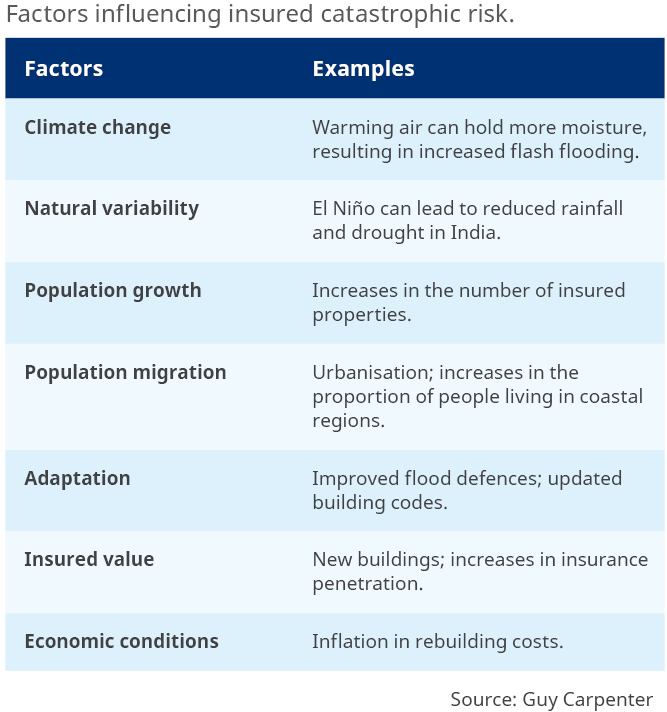
Managing Climate Change Physical Risk In The Middle East And Africa
Climate Change Impact by Peril
We evaluate the impact of climate change on a peril based on observations, climate models and our understanding of the physical drivers. In cases where we have a consistent view—a long observational record, high-resolution climate model output and a good understanding of the physical drivers—then we will have high confidence in our assessment. Conversely, there are many reasons why we would have lower confidence—for example, if an observational record is short or unreliable, or if there is disagreement between different climate models.
Here we summarise the climate change impact on floods, severe convective storms, tropical cyclones (TCs), wildfire, and heat waves and droughts. These perils are the most likely to be associated with a catastrophic insured loss, but there are also other perils impacted by climate change, such as sand and dust storms, and subsidence.
Climate Change Impacts on Flooding
The impact of climate change on flood is complex. Intense rainfall has a relatively direct link to surface water flooding, and therefore the climate change impact is generally well understood. In contrast, the response of riverine flooding to precipitation is dependent on a large number of factors, including soil moisture, temperature and catchment characteristics, and therefore changes are harder to predict and highly regional.
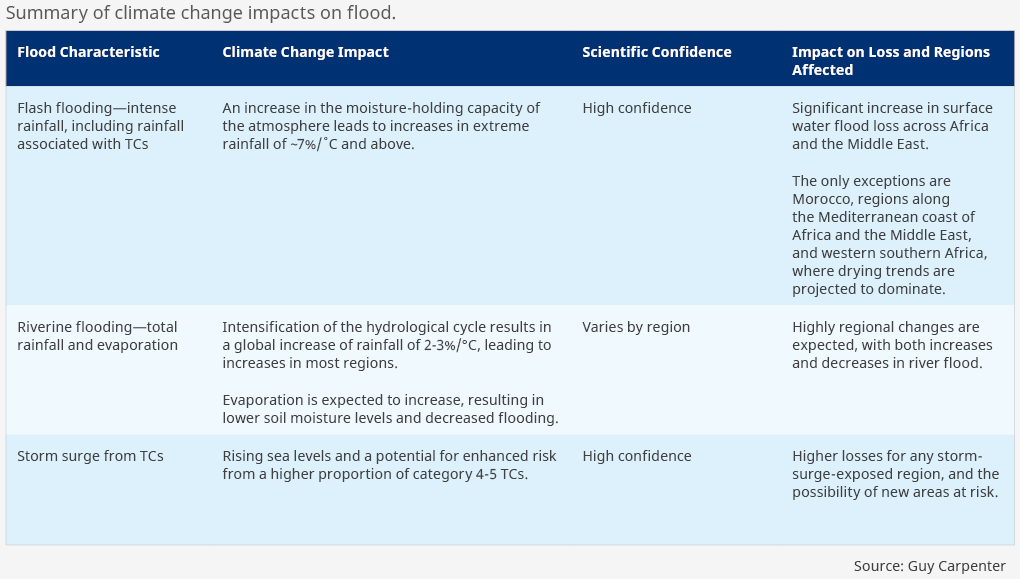
Climate Change Impacts on Severe Convective Storm
Severe convective storms include the sub-perils of hail, tornadoes and straight-line winds. All of these sub-perils need convective energy to develop—a source of moisture and heat at lower levels of the atmosphere. They also require wind shear—a difference in wind at upper and lower levels—to set up a storm of severity sufficient to produce hail or damaging winds. Finally, for hail specifically, the melting level—the height at which water freezes— needs to be sufficiently low for the convective cell to penetrate it and for hail to form. Climate change has a different impact on each of these drivers of severe convective storms, and they are explored below.

Climate Change Impacts on Tropical Cyclones
Climate change affects the frequency, severity and location of TCs in the North and South Indian oceans, as outlined in the table below. The impacts are wide-ranging, as the energy source of TCs (the ocean), the winds that inhibit their growth (wind shear) and the large-scale circulation pattern that steers them are all affected. There are also implications for the precipitation and coastal flooding associated with TCs, included in the table Summary of climate change impact on flooding.
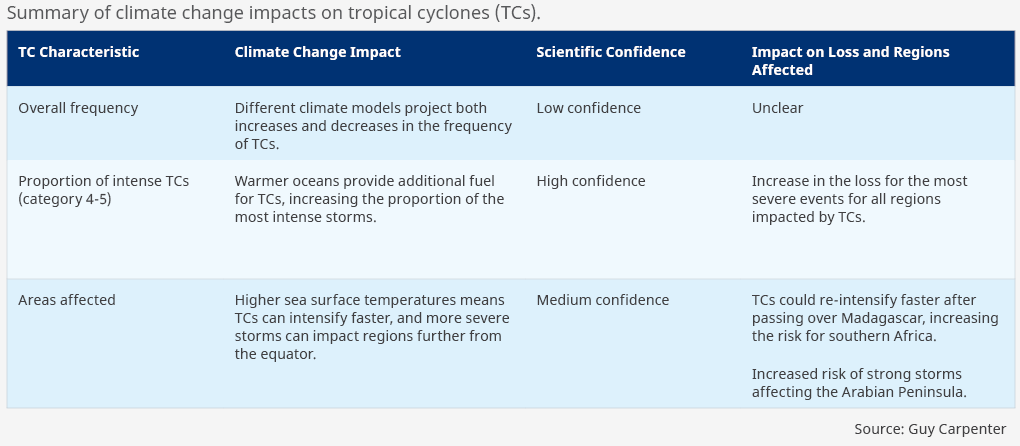
Climate Change Impacts on Fire Weather
Wildfire risk changes are driven primarily by projected trends in temperature and precipitation. However, this peril is unique in that there are significant human factors, including ignition, suppression, mitigation and various levels of built-in property resilience. We focus on the changes to fire weather in a changing climate but caution that sufficiently strong fire-suppression efforts can potentially outweigh increases in fire weather.

Climate Change Impacts on Heat Waves and Droughts
Climate change increases surface temperatures, generally increasing the risk of heat waves. The impact is amplified in hot regions, including the Middle East and Africa, which are already close to critical temperature thresholds. In contrast, the impact of climate change on drought is more complex, as it is influenced by temperature, via evapotranspiration, and precipitation, in addition to human activities, such as reservoir operation and water abstraction.
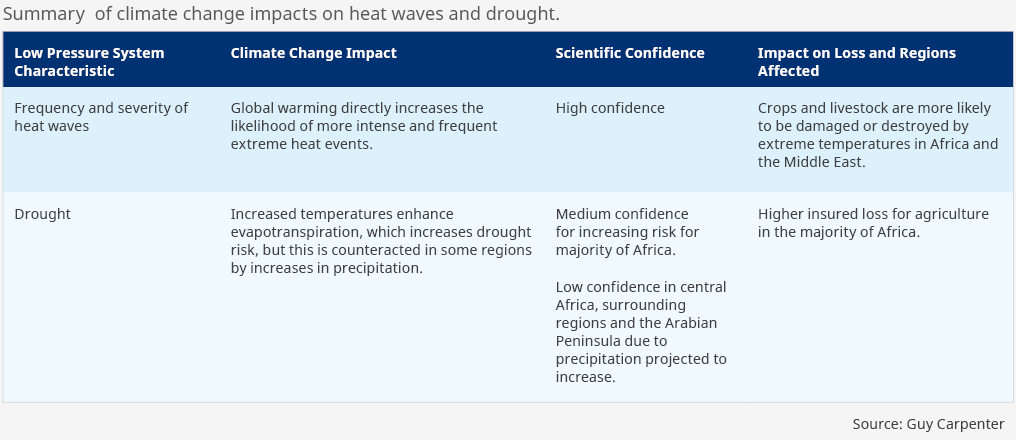
Managing Climate Change Physical Risk In The Middle East And Africa
Quantifying your Climate Change Physical Risk
There are a growing number of reasons for quantifying your climate change risk:
- Responding to regulatory requests.
- Representation of risk to third parties, such as credit rating agencies, investors or reinsurers.
- Making a TCFD-aligned climate disclosure.
- Incorporating climate change into risk management, pricing and capital decisions.
The type of risk assessment to carry out will be dependent on the use case. Important questions to consider before making any climate change assessment include the following:
- Is a qualitative or quantitative assessment required?
- What scenarios are of interest? This could be a specific emissions pathway and time horizon, for example RCP-4.5 in 2050, or instead a global warming level scenario, for example 1.5°C.
- Do you require an assessment on whether existing climate change is adequately represented in your current view of risk?
- What form of data is required to embed the climate change assessment in your existing decision-making processes?
Guy Carpenter is helping our clients address these questions and quantify their climate change physical risk through a variety of methods. For the quantification of the risk, Guy Carpenter has developed proprietary tools, ranging from underwriting and accumulation layers, to adjustments to third-party catastrophe models and in-house probabilistic models developed for climate change. Furthermore, we have a broad overview of market practices that can help clients benchmark their own activities.
For Africa and the Middle East, we have an inland flood model adjustment that provides a fully probabilistic climate change assessment. For South Africa, we also have a climate change view for hail.
Data Requirements
For a quantitative assessment of your climate change risk, a baseline view is required. This can be a catastrophe model run for your portfolio, but in regions with no catastrophe model coverage, then a climate change view can still be estimated where there is a baseline view on the average annual loss, and/or aggregate/occurrence exceedance probability.
Conclusions
An improved scientific understanding of how perils are changing and the fact that an increasing number of regulators are exploring climate-related disclosures means quantifying your climate change risk has never been more important. Doing so may also help avoid unexpected loss from evolving tropical cyclones and flood risk. It is also important to be aware that climate change may not be the most significant driver of changes in loss for your portfolio. Other factors, such as natural variability and inflation, should be properly considered to inform risk management, pricing and capital decisions.
